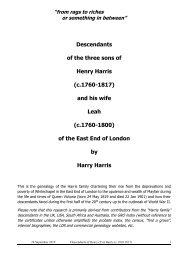You also want an ePaper? Increase the reach of your titles
YUMPU automatically turns print PDFs into web optimized ePapers that Google loves.
FIELDS IN
KING'S WOOD Part 8
So far, we have established that LiDAR images
unexpectedly reveal clear evidence of what
appear to be field boundaries in King's Wood,
that the underlying soft chalk rather than the
expected clay with flints would have allowed
early farmers to plough, that historical evidence
finds no evidence for medieval or Saxon use of
the fields and so suggests a Roman or earlier
origin. Four centuries of Roman occupation
resulted in an intensive agrarian economy and
there is abundant evidence of Romano-British
activity close to King’s Wood with the Roman
road along the Wycombe valley, two farmsteads
in Micklefield and, most recently, the possibility
of a Roman villa site in Gomm Valley near
Cock Lane.
Roman or Celtic field shapes &
sizes? In the absence of dateable finds in
King’s Wood itself, do the shape and size of the
fields offer any clue as to their age? Very little
direct evidence of Roman field systems has
www.pennandtylersgreen.org.uk
Village Voice December 2020/January 2021
survived in the Chilterns, but judging from
Romano-British fields elsewhere, those on the
Chiltern farms would have been roughly oblong
areas delineated by small banks and ditches and
ploughed one-way, rather than the crossploughing
of the earlier small, square, so-called
‘Celtic’ fields, which can date from the Bronze
Age (c.2000-600BC), as well as the Iron Age (c.
600BC- Roman arrival in AD43). These Celtic
fields were typically 1 acre (64m x 64m), the
amount which could then be ploughed in one
day.
The King’s Wood fields
The size of the fields varies considerably. The
two largest are rectangular and about 3½ acres.
Six fields, the majority, are squarish with
between 2 and 2½ acres and sides around a
norm of about 100m. The two smallest are
½-acre and ¾-acre squares. The direction of
slope within each field is consistent. All the
straight-edged field boundaries have the same
NE/SW alignment, taking their direction from
and incorporating parts of the longer, sinuous
lynchets which presumably preceded them.
These sinuous lynchets were created by
ploughing along the contours to form strip
lynchets, narrow flights of terraces on the
steeper slopes. There is some
evidence for more terracing than
has been shown on the map, on
the south-facing Tylers Green
side of the wood.
Thus, the fields do not fit
comfortably into what little is
known about Roman and Celtic
fields in the Chilterns, but many
of the banks are still very
considerable, even after nearly
two millenia of erosion, as
woodland, and must be the
product of immense labour over
many centuries. The Romans
would have inherited the fields
and probably adapted them to
some degree. Miles Green
37
















